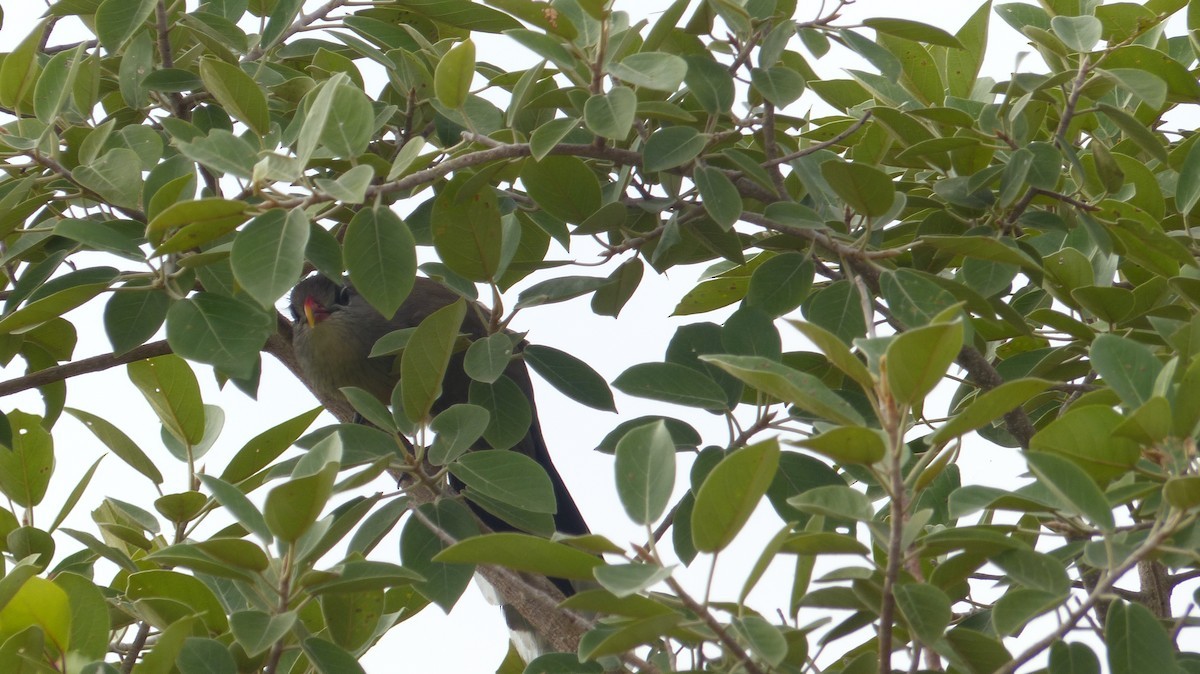Sirkeer Malkoha
A species of Malkoha Scientific name : Taccocua leschenaultii Genus : Malkoha
Sirkeer Malkoha, A species of Malkoha
Botanical name: Taccocua leschenaultii
Genus: Malkoha
Content
Description General Info
 Photo By Ashwin Viswanathan
Photo By Ashwin Viswanathan Description
The sirkeer cuckoo is about 42–44 centimetres (16 ⁄2–17 ⁄4 in) long with dark olive brown on the back, wings and the central tail feathers. The underside is rufous. A greenish gloss is visible on the wing and dark parts of the tail feathers. The feathers have dark shafts which are especially prominent on the breast as streaks. The tail is graduated (with outer feathers being sequentially shorter) and tipped broadly in white. The upper tail coverts are long. The chin, throat and breast are pale. The most distinctive feature is the curved red bill with a yellow tip. The eyes have curved and long bristles around the eye but not behind it that resemble eyelashes (an adaptation to protect their eyes when creeping through grass and vegetation) and the iris is reddish brown. They have a short and pale whitish streak over and below the eye and a thin line of black feathers in line with the commisure of the bill that reaches under the eye. A dark bare patch of skin around the eye that tapers behind it exaggerates the size of the eye. The legs are grey. They have zygodactyle feet and are forage on the ground, on rocks or between grass and bushes in scrub and thin forest, often in hilly ground but generally below an altitude of about 1500 m above sea level. They feed on caterpillars, insects and other invertebrates, small vertebrates, and on berries and seeds. When disturbed they creep through dense bushes and run on the ground almost appearing like a mongoose. Their flight is weak. They are normally very silent but produce a low buzzing zwik, or a sharp and repeated kik or kek sounds with a tone similar to the calls of a rose-ringed parakeet. The primaries at the wing tip from the longest to the shortest are 7>6>5>8>4>3>2>1>9>10. The primary moult is from August to December while the second moult occurs in April. The populations, P. l. sirkee in northwestern India (Rajasthan, Gujarat and Sind) are pale and have a yellowish throat and breast. The populations in the Eastern Himalayas are darker and larger and are considered to be a subspecies infuscata described by Edward Blyth (Latin scholars suggest it should be spelled infuscatus when used in the genus Phaenicophaeus). The nominate subspecies is intermediate in coloration and is distributed across Peninsular India and extends into Sri Lanka. The species is placed in the genus Taccocua erected by Lesson in 1831 but some authors place it in the genus Phaenicophaeus. The genus Taccocua was separated from that of Rhopodytes (usually merged into Phaenicophaeus) by the bill being narrower at the base and the upper mandible being festooned at the base. The generic name is derived from the French word "taco" used for lizard cuckoos in the genus Coccyzus (earlier Saurothera) combined with the genus name Coua while the species epithet commemorates the French botanist Jean Baptiste Leschenault de la Tour while the name "sirkeer" has been claimed by James Jobling to be from the local name "sirkee" used for the bird in Gujarat although Blanford noted that the supposed Indian names "Surkool" or "Sircea" of Latham were untraceable. One theory is that they were often found in areas with reeds called sirkanda (Saccharum sp., possibly S. bengalense Retz.) in northern India from which mats used as curtains known as sirkee (sirkean in plural) were manufactured. Across much of northern India, it is known locally as junglee tota meaning jungle parrot (or parakeet) based on the similarity of the bill to that of the locally familiar rose-ringed parakeet. 
Size
43 cm
Nest Placement
Tree
Feeding Habits
Sirkeer Malkoha predominantly consumes large insects, such as grasshoppers and mantids, caterpillars, termites, as well as lizards, berries, and fruits. This ground forager is known for its terrestrial feeding behavior, which includes running on the ground and infrequently flying from tree to tree.
Habitat
The sirkeer Malkoha typically inhabits dry deciduous forests with secondary growth, dense scrub and bush areas, and jungle terrain with thorns and tall grasses. They are also found in regions with underbrush composed of lantana and areas with dry, stony hillsides. Preferred environments are in plains, foothills, and lowland regions of broader South Asian territories.
Dite type
Carnivorous
General Info
Feeding Habits
Bird food type
Distribution Area
All of the sub-Himalayan Indian subcontinent, Bangladesh, Sri Lanka; patchily in Pakistan and Rajasthan. They are thought to have expanded into the Sind region in the 1930s following the construction of the Sukkur barrage and the extension of canal irrigation. Three subspecies have been designated, varying in colouration but showing continuous variation and having no disjunctions in their distribution ranges. 

 Photo By Ashwin Viswanathan
Photo By Ashwin Viswanathan Scientific Classification
Phylum
Chordates Class
Birds Order
Cuckoos and Relatives Family
Cuckoos Genus
Malkoha Species
Sirkeer Malkoha